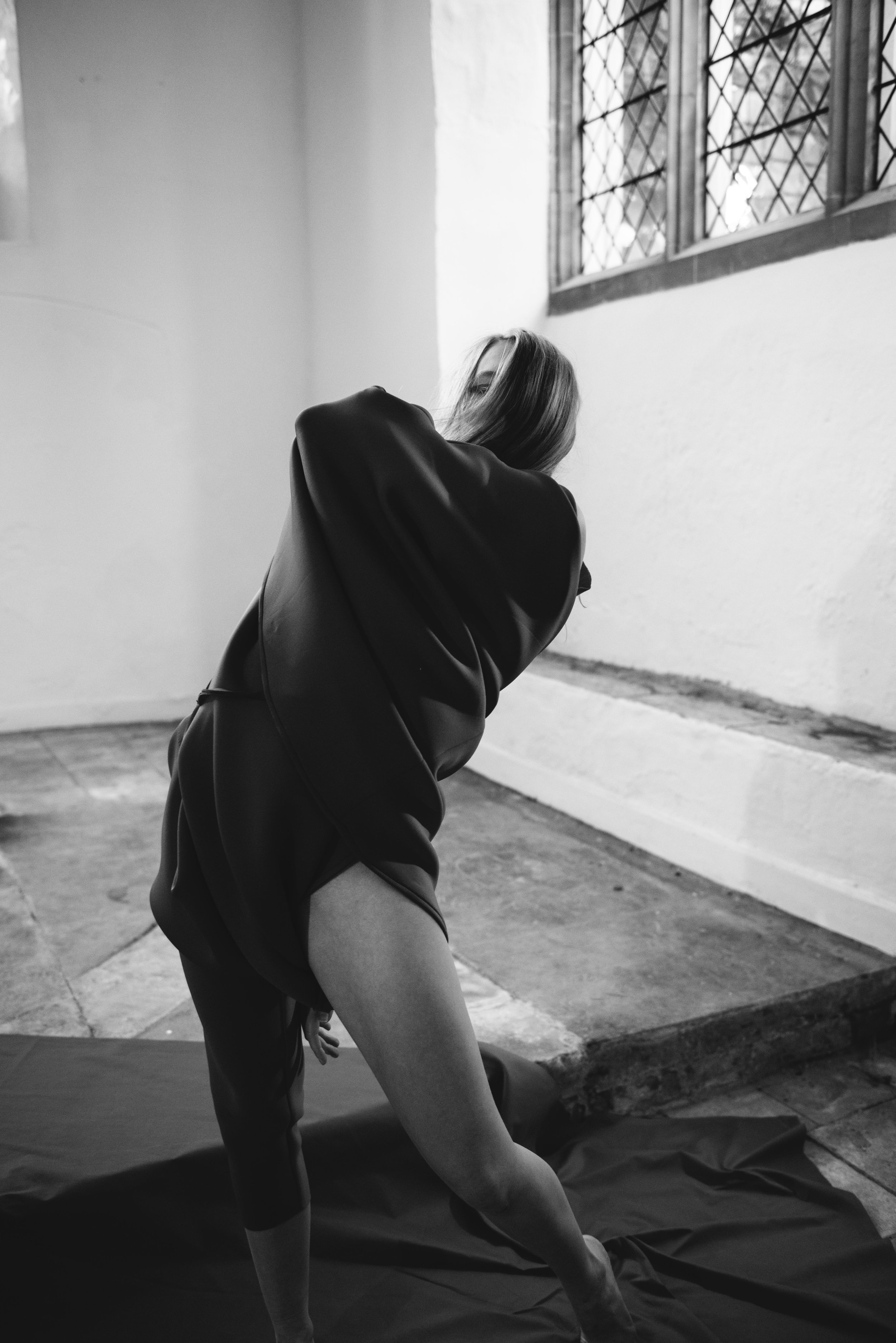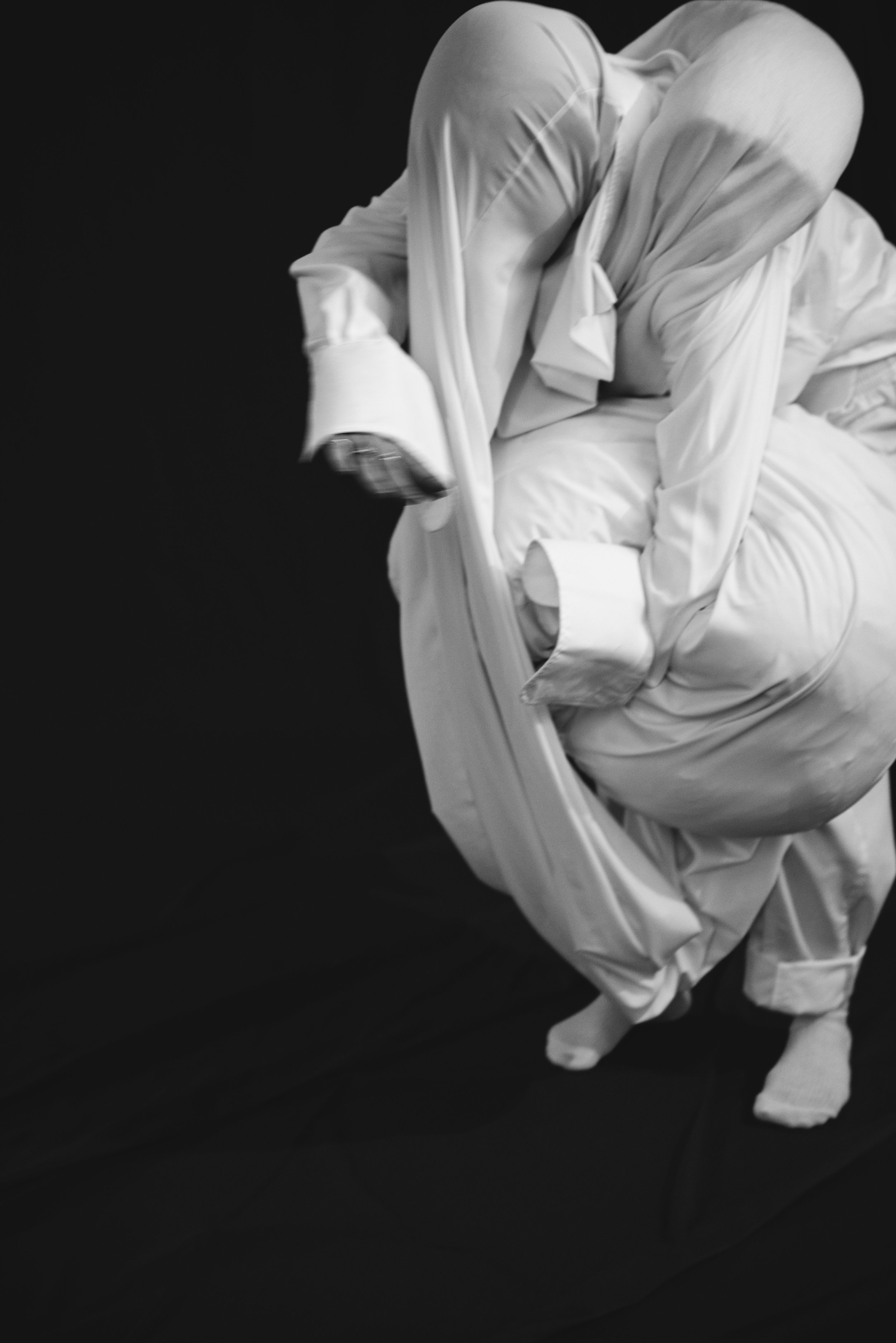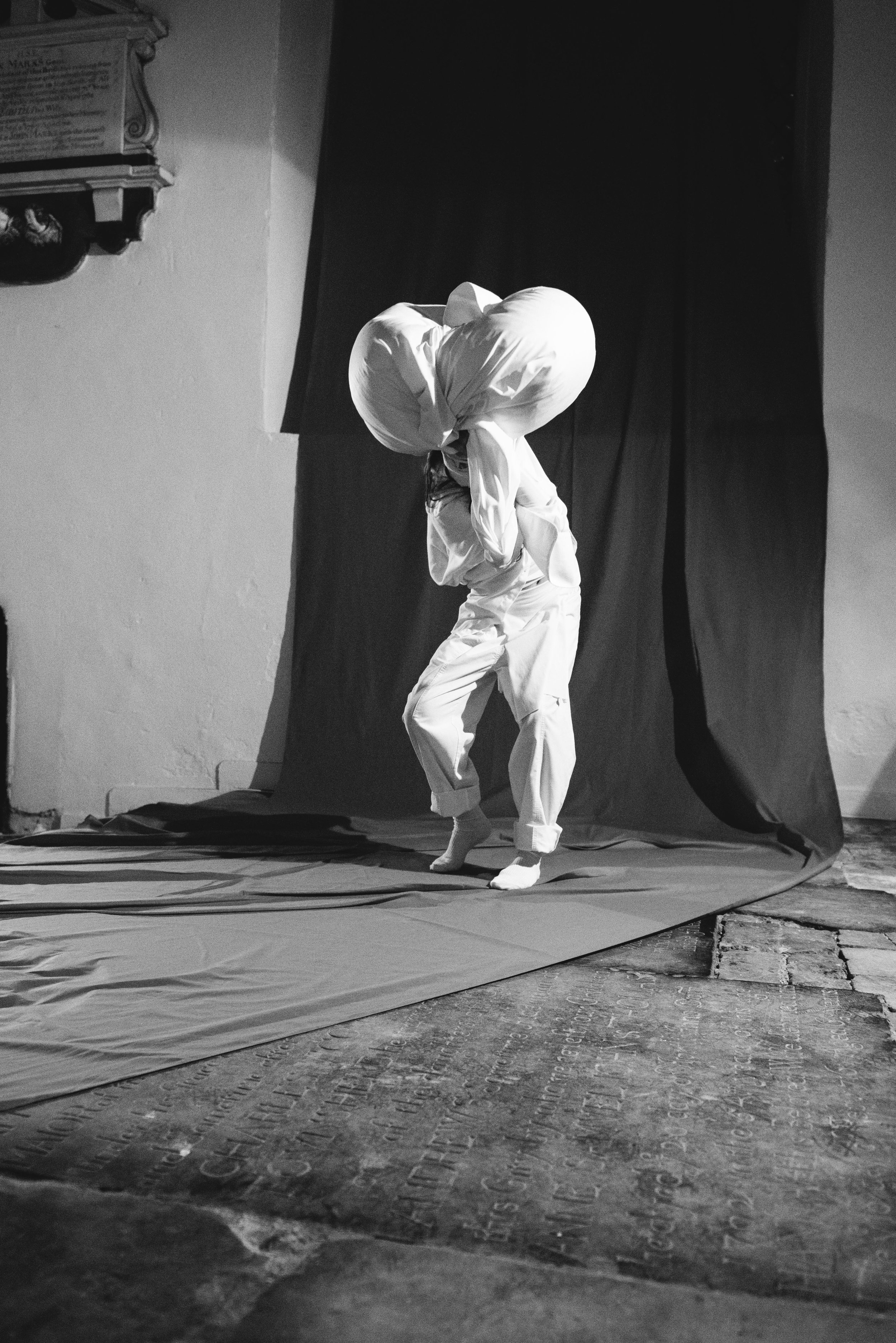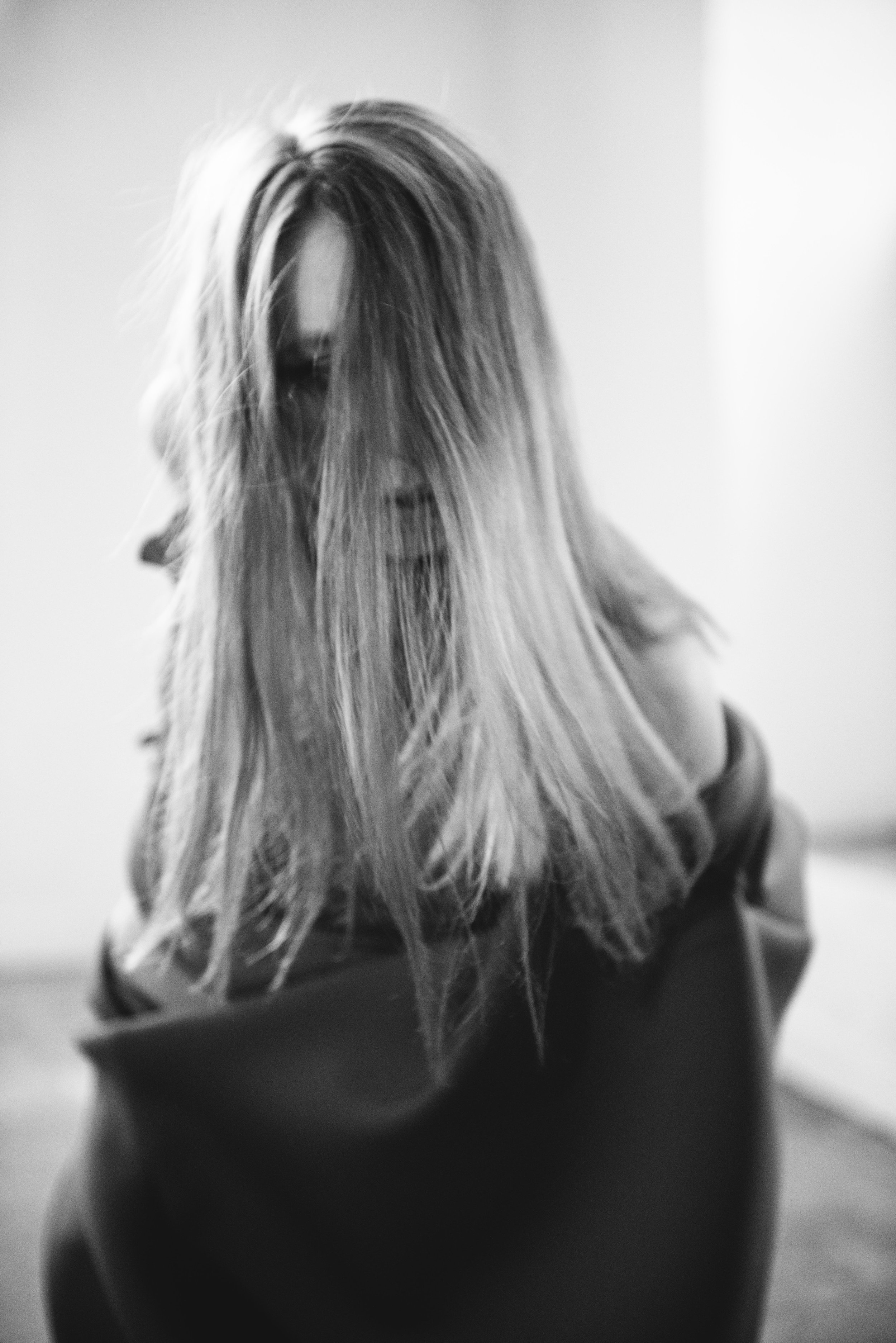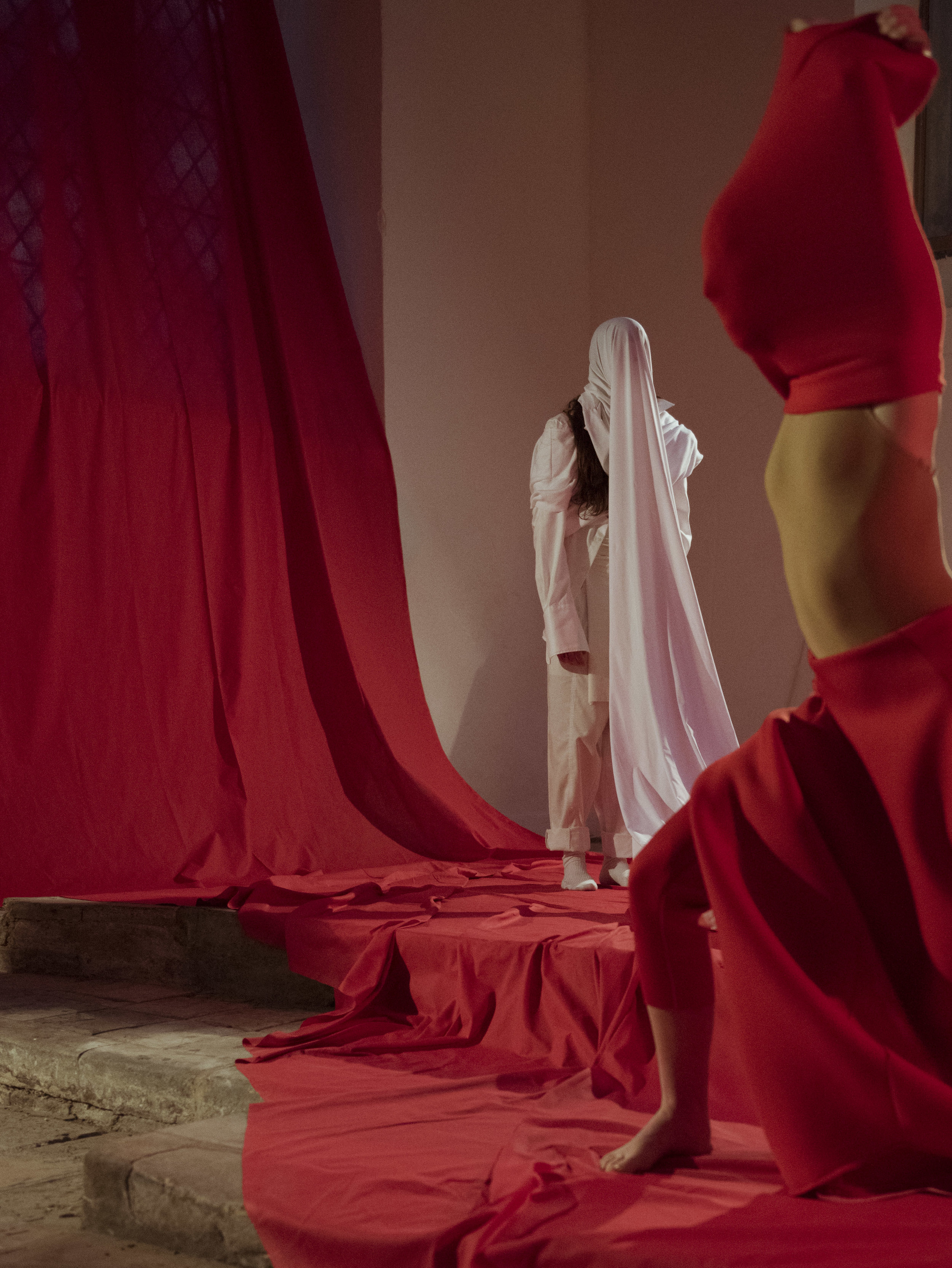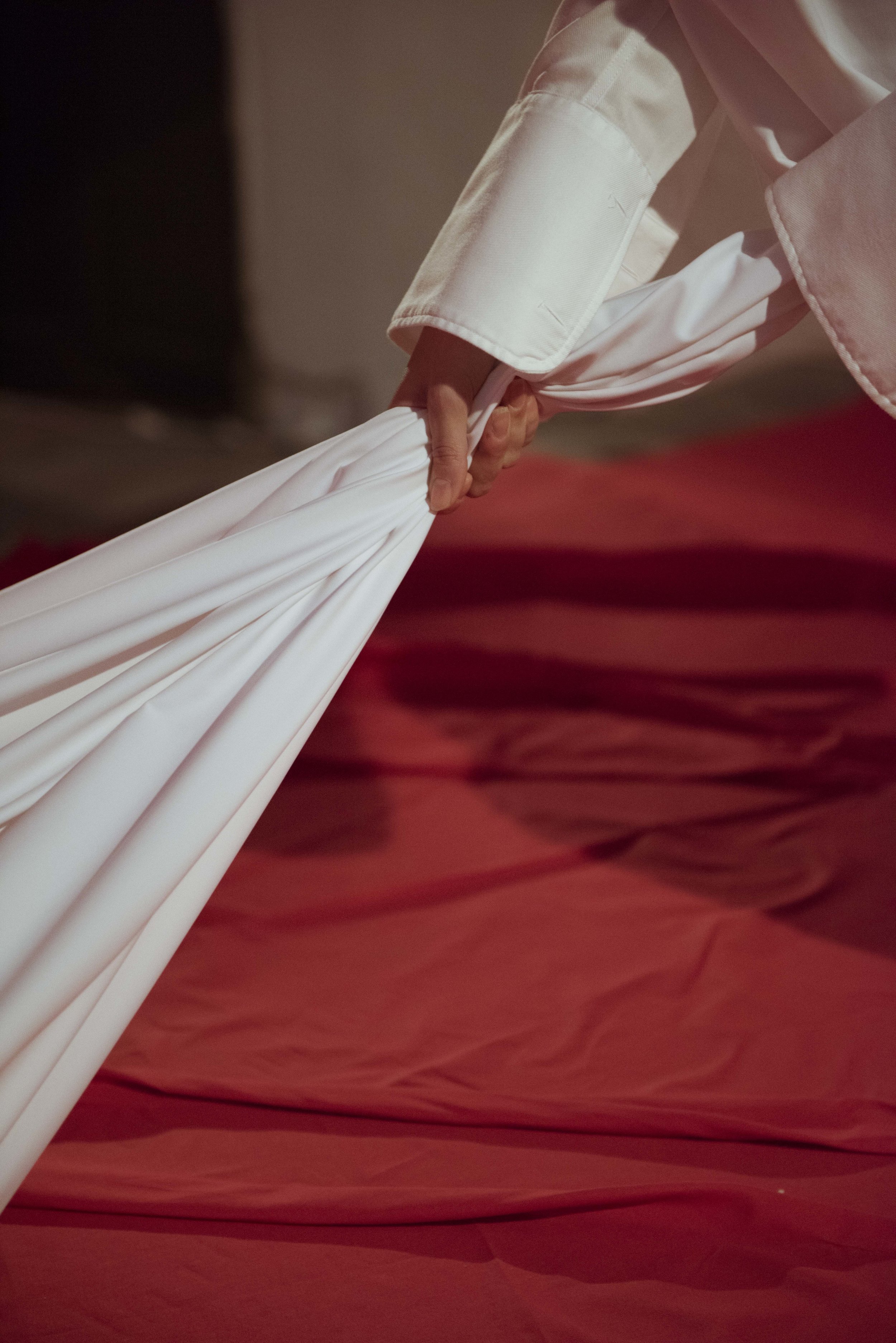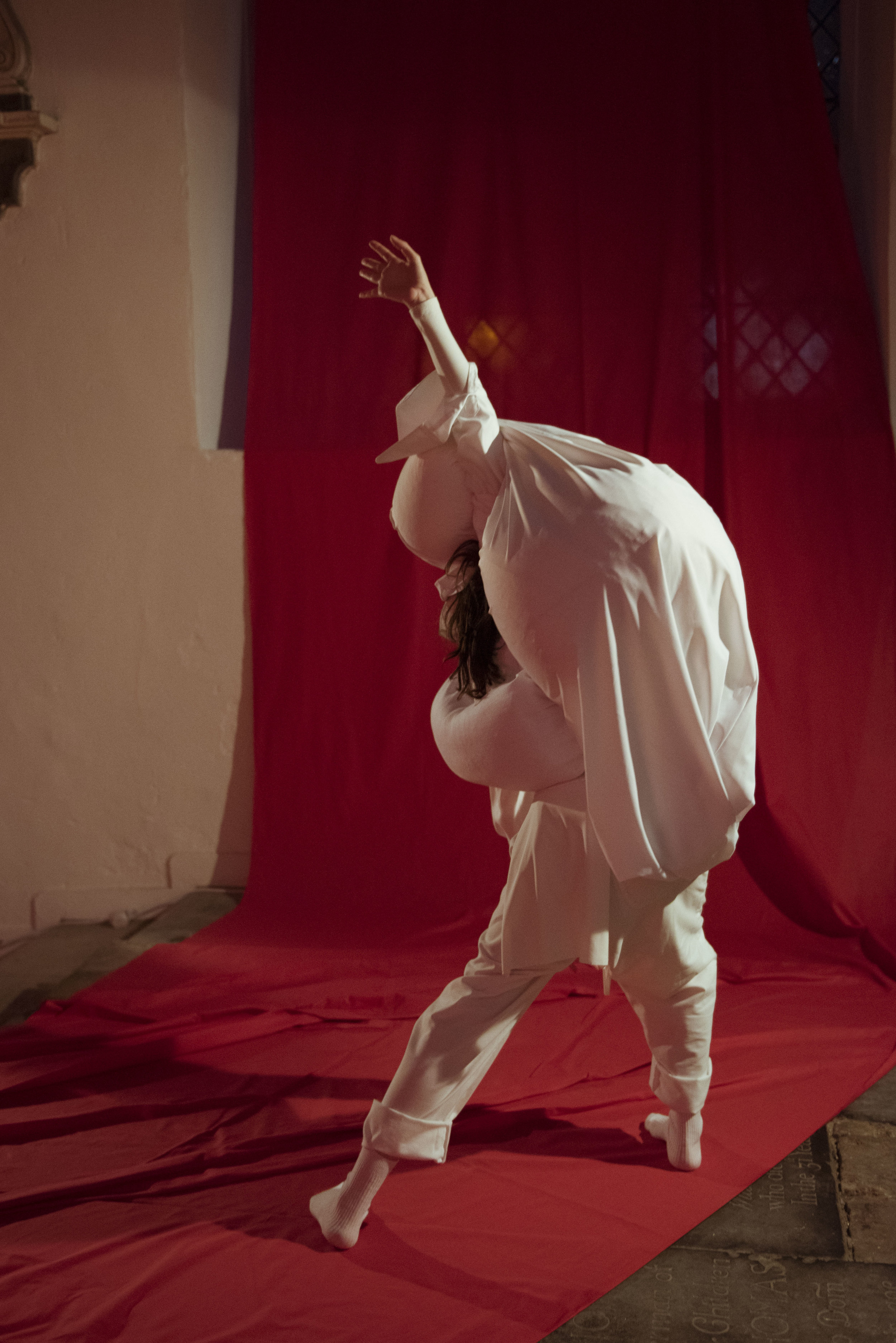Written by Calla Camero
Photography by Kerry Curl
When London-based dancer and choreographer Amy Ollett decided to shift her career path, and go back to school to get her Master’s degree in fashion design, she knew she was stepping out of her comfort zone. But with this risk, came artistic transformation, allowing her to take dance to places she hasn’t gone before.
Since obtaining her Master’s degree, Amy has merged her love of design with her passion for dance, by creating unconventional dance wear pieces, often drenched in symbolism, and choreograph the movement to accompany each dancer in their respective outfit. The result is a strange and spectacular type of performance art, that comes out of the breaking of boundaries- both in dance and fashion.
Her latest show titled Milk, shows dancers wrapped in layers of clothing, some protruding from the body, others tight-fitting, confronting society’s idea of women and how that impacts the way women think. Amy’s choreography challenged the audience to understand that through movement, women are able to wear their layers in more than one way.
Here’s our full conversation with conceptual designer and choreographer, Amy Ollett.
When did you start dancing?
I took classes when I was younger and always remained a part of it growing up with my friends, but it wasn’t until I was around 14 when I took my first class in hip-hop and it just clicked. Immediately for me it was decided, I went home afterwards and told my mum that I’d found what I wanted in life. I haven’t looked back since. I think now I realize it wasn’t so much the style but it was the first time I felt free in my own movement and what movement can be. I was addicted.
How did your interest in fashion design spark?
I trained as a dancer, before all of this design element came in. When I was studying, I focused a lot of my time on choreography, and that’s what really resonated with me. It was the thing that really allowed me to share a voice, rather than being a performer. When I started to do more and more choreography, I realized there was a lot of design element coming in because I’ve always admired fashion and I had used a lot of heavy imagery in my work before. So when I returned back to London, I knew I wanted to explore this more and I guess I just finally took the risk and decided that I wanted to get a masters degree in fashion, which in England is quite a difficult thing to do if you haven’t done fashion before.
How did you start transforming your dance choreography into design?
When I knew I wanted to research it further, as soon as I started the master's degree program I decided to do a series of experiments with dancers that I knew and material play, so we explored different ways of using material but also how it affects our body so a lot to do with the sense, you know -- feel, touch, smell -- everything that contributed to a different reaction from the material to the body. So we just kept exploring that, and that's how I developed it into deeper research to allow me to create designs that played on this.
A lot of the designs that I made after the year (in school) was I guess more challenging to what the body could do, and I wanted to extend the lines of movement rather than hide that by just using tight material.
What a beautiful challenge.
I think I was really surprised at where it sort of took within my research because I think in dance, there are just no boundaries, and it’s really limitless with what you can do. But I didn’t realize the scope of what I could achieve with just materials, and I’m still challenged today even when I’m doing new work. It is hard because I want to keep making something that is challenging but also original. But of course, that’s challenging for any artist. So I just keep remaining on that push of how can I explore more movement play with dancers that isn’t just I guess a generic way of doing it.
What do you mean by generic?
I guess I didn’t want to keep putting them in leotards or things that were really accessible for dancers. I wanted it to be a challenge for them, which is why I went on to explore a lot more the idea of it being fashion rather than costume. Because I felt like costume was just adding the final look, rather than actually being a part of the process of creating choreography. Which is where it sort of happens. As soon as I’m in the studio with the dancer, they’re in the studio with the garment, because they have to build a relationship together to create new movement, otherwise it just doesn’t work cohesively.
What types of materials do you generally use in your designs?
I’m definitely a much more unconventional material user. For my last couple of projects I used a lot of foam and neoprene which is used for scuba divers, anything that has a strong dynamic. The good thing about foam is it’s not very conventional. You wouldn’t necessarily buy many things that are made of foam, but dynamically it gave so much movement to them as well. I like things that accentuate that.
What’s a typical workday for you since finishing the master’s program?
My typical day would be to go to the studio, explore my ideas, it’s a lot of emailing you have to do, of course. I try really hard to stay consistent. And also to keep moving in my own body, because it’s hard when you’re trained as a dancer and now you’re focused on different elements, it’s hard to keep that momentum in your own movement.
Can you walk me through your creative process, with choreography as well?
I work a lot from my own emotions and feelings. So I definitely start with a concept and idea of an emotion I want to express, and then this is normally reflective of a fabric I might pick to sort of mirror what I’m feeling, and challenge that.
And then typically I’ll get into the studio with the dancer and the material I’ve chosen, and we’ll play with it for a good couple of hours just to see the silhouette that I could create. What kind of imagery is it creating together with the body.
I’ll also record this for film and photography. This will allow me to break it down a lot more, then I can build a lot more of the design element... how can I reconstruct it? What forces do I need to add in? Does it need something that’s more restrictive for the lower body, more freedom for the upper body? Just playing with these elements and I’ll keep going back and forth with the dancer in the studio, developing the design as we go. So it really is a sort of vigorous process between the dancer and garment, which is created together rather than separately.
From this, once it’s finished, this is a time where we can actually start setting choreography, understanding the emotion intention behind it. But also because I’m such a heavy visual artist, we will start thinking of the sight, place, the set, because everything will enhance or change the garment, depending on what I need. But the main process for me is really having a garment that is created alongside a dancer. This will go all the way from improvisation to the material, all the way to set choreography with the garment itself.
Are there other things that you have to weave into your day to day, that make creating difficult?
For me what’s been difficult is the practicality of it, of course. You know, having a part time job to help pay for it has been really challenging to fit in with this schedule. Because when you’re a creative you can’t just switch it off sometimes. One morning you might wake up with an idea that you wanna work with all day, but if I have to work then I have to put that to the side for a bit.
How do you manage your time between choreographing, design, and your side jobs?
It is difficult but I let each area decide for themselves, in terms of how much time I give each role. Of course, with teaching jobs and other part-time work, I can’t always control when it is happening but I have learned to accept that when it does come, to let go of any fear of not putting the same time back into the work itself. Ultimately, each position I take coincides with one another, so I must let them have an even balance, otherwise one can fall off the side for some time.
It’s the same with the choreography side to the design side, sometimes one wants to overpower more than the other, therefore I let it take over naturally. However, I do believe the work has grown now where organically they happen together, there is a married relationship between the work and it is committed to one another.
How do you unplug from it all?
I’m not sure if I do, it’s extremely hard to unplug when it isn’t something detachable. Nevertheless, I do small things that helps to ease the pressure. Growing up in the countryside and going back to nature is something that gives me great freedom and keeps the balance between both sides of me. Anything that helps me to escape for a few minutes is extremely hard to find but very valuable time to have had.
When you feel stuck creatively, how do you get out of it?
Whenever I feel stuck creatively, I stop being creative at all. I have spent so much time trying to rip ideas out of me that never even reach the surface, because it wasn’t natural or healthy. I used dance as a way out of that pressure when I was younger but now I struggle to not feel pressure at all when I’m moving. That’s why I think the work can be so disruptive and has channelled into its different forms, because I never feel comfortable. I’ve learned to value that, the comfortability within the uncomfortable.
Are you dancer first, designer second? Does the order matter?
I’m not sure if this order matters but I have always felt like a dancer first. As dancers, we have a relationship and understanding of the world/space around us differently than others. I think this is because of the intimate vocabulary and communication we have with our bodies and this is what I have carried through into my design work. I have always liked to say, I choreograph clothes and design movement. I treat one like the other, I am as tough on the body as I am with garments.
What’s been the biggest challenge? Biggest reward?
I believe my biggest challenge for myself is also my biggest asset, and that is I’m different. I am accepted and avoided the same, especially because I am working within two fields trying to create one and the industry doesn’t like that. However, there are very clear gaps that welcome it wholeheartedly and those gaps are spreading all the time. This challenge excites me and as a stubborn creative is something I like to drive and prove, that you can be skin, blood and bone without the need to ‘sell’ yourself. For me this will be and is my biggest reward.
What feedback have you received the fashion community?
I think it’s actually been really positive. I guess in some way, having the Master’s degree was a way for people to accept that, okay, she’s sort of in somehow. Which is really backwards, but I guess it’s the way the structure is here. But because I was coming from a different discipline, I think people didn’t have an expectation of me. So I was allowed to throw out whatever I wanted and refine it in a way, and I think now that I’ve come out and shown it, people are very surprised. I think it’s difficult in fashion because it can be very boxed. And I am trying to do something different and with fashion, although it can be very innovative, people don’t always like change.
What’s more challenging - creating choreography or designs?
This changes every time, depending if the work is focussing on one more than the other, or if one has taken over that period of time. There have been a few times when a design has come so quickly and aggressively that it takes over everything and becomes a creature very rapidly. Once its first stage is done then more movement/dance is introduced to enter the next stage and so on. They are both forever exchanging back through how I am feeling, and that is what is challenging the most. I lose control of what is being created from them because ultimately, I can’t change the way I am feeling, so decisions come unconsciously and very unapologetically.





